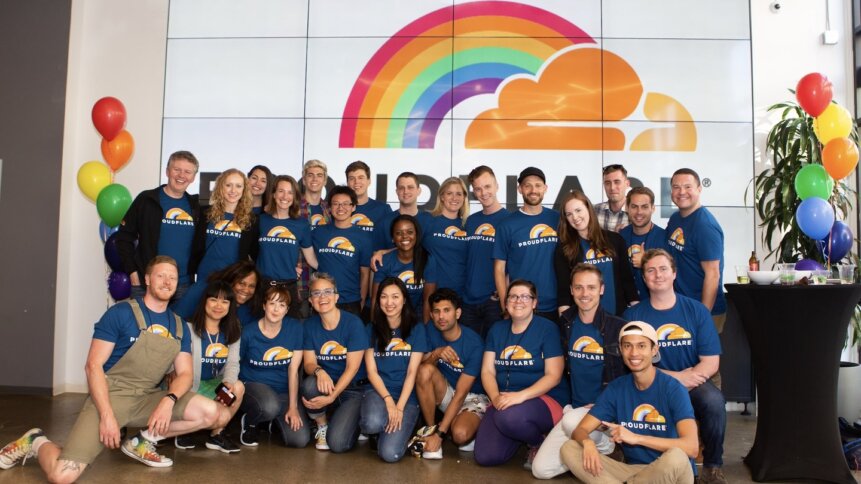Women in Tech: building community

• Inclusive workplace cultures allow people to be authentic.
• People need points of community, and will find them.
• Increasing the points of community in a company can bring creativity and curiosity to the fore.
In Part 1 of this article, we spoke to Jen Taylor, Chief Product Officer at Cloudflare (and formerly of Salesforce, Facebook, and Adobe) about the barriers she still sees to women’s entry into – and progress through – careers in the tech industry.
Ending Part 1 on an optimistic note though, Jen mentioned that she had seen workplace cultures developing in tech in which more genuine inclusivity was palpable, and where people – all people – were freer to experiment, to learn and to grow.
We wanted to explore the potential connections between those two factors.
THQ:
Do you think there’s a direct connection between inclusivity in the workplace and that freedom to experiment and grow which you’ve said is an important element to attracting more women into careers in tech?
JT:
I draw a pretty direct connection, yes. I think if there’s an environment where you’re made to feel comfortable, to speak your mind and be yourself and bring your perspective, it encourages people to bring their whole selves to work.
For me, whether it’s coming in as a woman, coming in as a lesbian, coming in as a wife, coming in as a mother of three kids, this is my perspective. This is my life, and this is how I see things.
Whatever your perspective is, if you feel comfortable and safe to bring that to the workplace, you’re going to be more fully you. We attribute a lot of our innovation to that inclusiveness, that atmosphere, and just really celebrating the curiosity that people bring with them.
READ NEXT

Women in Tech: barriers to inclusion
More opportunity builds a stronger community.
THQ:
There’s been some perception that women are still being made to fight one another for opportunity and visibility in the tech industry. Does that feel like a valid idea in the 2020s?
JT:
When I think about the challenges that women have in the workplace, a lot of it is tied up in making sure that when people think about diverse and inclusive workforces, that they’re not doing it on a quota system, that they’re not like, “Oh, I’ve got x-number of seats for women, and y-number of seats for men and z-number of seats for people of color” and the like.
It’s about making sure that you’re creating that kind of categorical focus on diversity and creating the space for it. I have watched women feel even more competitive with other women than they’ve been with men, because there was this sense that there were only so many seats at the table for them.
The more we can do to dispel that myth, and really create a sense that there are plenty of opportunities for everybody who is qualified, and is curious, and wants to work hard and grow and do the work, the easier it will make the situation. And I think it makes the community of the women within the organization much stronger.
THQ:
That’s the key, isn’t it? The idea of scarcity of opportunity being a driver to achieve what can be achieved. And if the number of opportunities is greater, then there’s not that combative element.
Talking to other leading women in tech, the idea came through strongly that the more women you have in the same tech environment, the easier it is to build those networks, build mentoring relationships, build sponsorship opportunities, and even just build those casual networks with which you can share the experience of being x-person in y-situation.
YOU MIGHT LIKE

Women in tech: new perspectives, new focus
JT:
It’s about building community, right? And it’s about finding familiarity within an organization. That goes a long way to helping people feel supported. I think people find a sense of connection and community based on all sorts of different attributes.
Can you see me now?
THQ:
We were going to ask about visibility. Is visibility for women in tech getting better?
JT:
I think so – but then, I’m a little biased, right? I love conversations like this, because they raise the visibility of women in technology. But it also shows that this is something we care about, and we’re going to keep talking about it until we feel like it’s solved. Until we feel like it’s better.
I also appreciate that you’re starting to see stronger communities of women within technology. Like Women in Product, which is a bunch of women who got together and started creating this conference for female product managers. And that happens around the globe, in both large venues and small.
There are all these different areas of focus on ways for women to find that sense of community and visibility. I think things only get better if we keep talking about them – and keep holding ourselves accountable for them getting better.
So I think it is getting better. Would I like it to be even better? Yes. But yeah-.
THQ:
It’s a journey. There’s absolutely the argument that it shouldn’t need to be a journey, but we are where we are, so…
JT:
Yeah, I wish it weren’t a journey. I wish a lot of things weren’t a journey. But I think if you look back at history, almost everything is.
THQ:
Tech has always historically been seen as not only a white male-dominated industry, but also heteronormative and cisgendered. Does being both a woman and a member of the LGBTQIA+ community in the tech industry give you a double bind of imposter syndrome?
JT:
I wish I could blame my moments of imposter syndrome on that! I’d love to be able to hang my hat on that.
It’s funny; I spoke to a woman today, and asked how it was going, she’s been at the organization for about a year, and she said “Well, you know, the first three months, I was just wrestling my imposter syndrome to the ground.”
It’s like being able to name it enables you to put it on the shelf. You can go “Oh, that sucks, I feel impostor syndrome,” and still move forward.
I do myself, and yes for me, there’s kind of the double bind of being both a woman and a lesbian. But it goes back to what we were saying a moment ago – how do I find community within an organization?
I feel privileged to have the ability to find community in many facets. And I think that most people do that too, they have these different facets that enable them to connect to different parts of the organization.
I will also say I am privileged to live in a bubble, which is San Francisco, so I’ve often joked that it has been easier for me to be an out lesbian than it has been for me to be out about the fact that I have an MBA in the tech world.
THQ:
Ha! “Cast out the MBA!”
JT:
The thing is, the desire to pull on some of these more diverse perspectives has made it more interesting. Sometimes I almost feel like I have to hide the things that are more conforming.
When I started at Cloudflare, as a female leader, I think that was very powerful. But it was also a very powerful, I think, for me as a lesbian.
I remember very early on in my time at Cloudflare, having other employees approach me and say “I really appreciate you’re here. Now that we have a clear leader, one of the things we wanted to do is create a queer community, a queer group, would you help us do that?”
And that became Proudflare.
It’s a privilege to be a part of that conversation and to be able to be a part of that leadership, and I feel like that’s a big part of how I think about the work that I do beyond the shipping of the products or the meaning.
It’s about how I can further the culture of the organization. And how I can give voice to different people within the organization, and create those points of community for more people.
People who find their community can do anything – capture castles, smash glass ceilings, or even just be their authentic selves in the workplace.

Jen Taylor, of Cloudflare.
In Part 3 of this article, we’ll discuss the importance of allyship in changing not just individual business cultures to provide community and unlock authenticity, but the whole industry’s culture, to make it more genuinely diverse.








